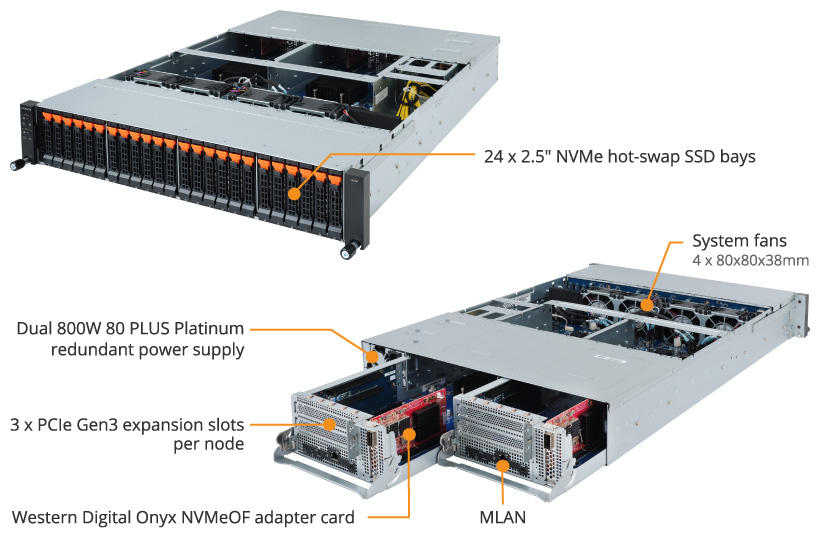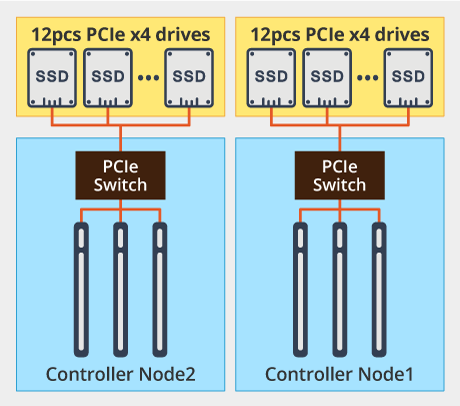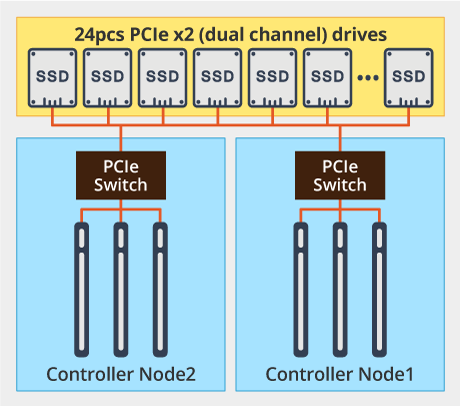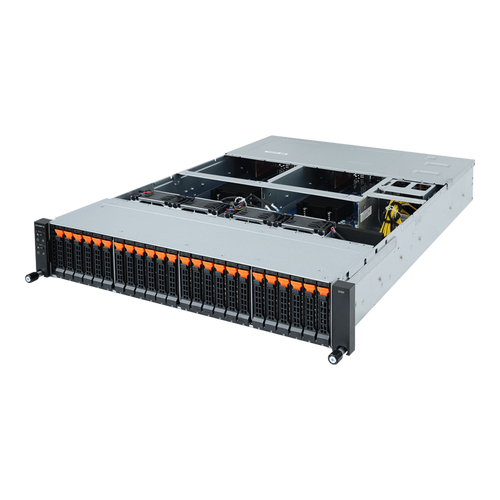Product Description
- Western Digital Onyx NVMe Over Fabric storage controller
- Fully supports iWARP, RoCE v1 and v2
- Dual controller architecture
- 1 x 100Gb/s or 2 x 50Gb/s Ethernet port(s) via QSFP28 interface
- 1 x AST2520 management port per node
- 24 x 2.5" NVMe hot-swappable bays
- 3 x PCIe Gen3 x16 slots per node
- Dual 800W 80 PLUS Platinum redundant power supply
NVMe Over Fabrics (NVMeOF)
Direct Attached NVMe Storage is Fast & Efficient, but Still Has Limitations…
- Direct attached NVMe storage has limited scalability, as PCIe is inherently not designed for expansion far outside the box.
- Direct attached storage offers little or no support for sharing of flash resources amongst multiple servers. Servers can only access flash in their own chassis.
- No sharing leads to storage utilization inefficiency and resource waste. Underutilized “stranded” or “dark” flash can be an issue

Bringing Scale-Out NVMe Storage Capabilities Independent of Compute
NVMe-OF enables NVMe-based communication over interconnects (“fabrics”) other than PCIe. This interface makes it possible to connect “external” storage enclosures to a server, either directly or through a switch, while still using NVMe as the fundamental communication mechanism. Flash storage can then be scaled out independent of compute.

Enabling Resource Disaggregation + Pooling to Maximize Efficiency & Minimize Under-utilization
Combined with virtualization, the amount and type of each resource (CPU, GPU, storage, networking) can be selected for each workload independent of where that resource is physically located in the data center.
 Current Datacenter: Server-Centric
Current Datacenter: Server-Centric Future Datacenter: Disaggregated
Future Datacenter: DisaggregatedS260-NF0 / NF1 Network Topology (RDMA Structure)

S260-NF0 Product Overview

S260-NF0 Block Diagram

S260-NF0 vs. S260-NF1
S260-NF0
Each node supports 12pcs PCIe x4 drives

S260-NF1
Each node supports 24pcs PCIe x2 drives
 1. Controller card needs to be defined on drive management
1. Controller card needs to be defined on drive management2. Controller node redundancy
Western Digital Onyx NVMeOF Adapter Card

- S260-NFx supports up to 6 x Western Digital Onyx NVMeOF adapter cards (3 per each controller node)
- Up to 2.5M random read and 2M random write IOPS per NVMeOF adapter card
- System can achieve up to 16M IOPS with 6 adapter cards
- Ideal solution for composable resource infrastructure
| Feature | Specification |
|---|---|
| SoC | Fuji, KN-103 21mm BGA |
| CPU | 4 cores |
| Power | 7W |
| Memory | 10MB |
| RDMA | iWARP, RoCEv1/v2 |
| Network | Single 100G or Dual 50G/25G/10G |
| PCIe | 16 lanes Gen3 |
Carefully Selected Components
GIGABYTE’s passive components are carefully selected to guarantee a stable operating environment and allow the processors and the memory to deliver their maximum performance. GIGABYTE’s server motherboards are built with long lasting components for a high degree of reliability and durability.

Design Features for Easy Maintenance
GIGABYTE platforms contain many tool less design features for easy installation, maintenance and removal – never worry about forgetting your toolbox or losing a screw again!
Tool-less Rail Kits
Rail kits attach to the side of the server chassis via clipping mechanism.

Tool-less 2.5” & 3.5” Drive Bays
Clipping mechanism secures the drive in place. Install or replace a new drive in seconds.

Efficient, Reliable Power Supply
GIGABYTE server are designed to guarantee high conversion efficiency regardless of load. Redundant 80 Plus ‘Titanium’ or ‘Platinum’ PSUs, combined with GIGABYTE’s precision engineering, translates to super efficient power usage which maximizes the system’s power : performance ratio and reduces OPEX for the user.

Dynamic Fan Speed Control
GIGABYTE servers are enabled with dynamic fan speed adjustment. Individual fan speed will be automatically adjusted according to the system’s current temperature (according to CPU, DIMM, M.2, HDD, GPU temperature sensors), to achieve the best cooling and power efficiency. When the BMC detects a temperature change, fan speed will be automatically adjusted accordingly. Fan speed profiles may also be manually created and edited* when necessary according to the user’s custom requirements.
 US Dollars
US Dollars
 United Arab Emirates Dirham
United Arab Emirates Dirham
 Euro
Euro
 British Pound
British Pound
 Turkish Lira
Turkish Lira
 Canadian Dollar
Canadian Dollar
 South African Rand
South African Rand
 Indian Rupee
Indian Rupee
 Brazilian Real
Brazilian Real
 Indonesian Rupiah
Indonesian Rupiah
 Singapore Dollar
Singapore Dollar
 South Korean Won
South Korean Won
 Japanese Yen
Japanese Yen
 Chinese Yuan
Chinese Yuan
 Mexican Peso
Mexican Peso
 Qatari Rial
Qatari Rial
 Saudi Riyal
Saudi Riyal


















